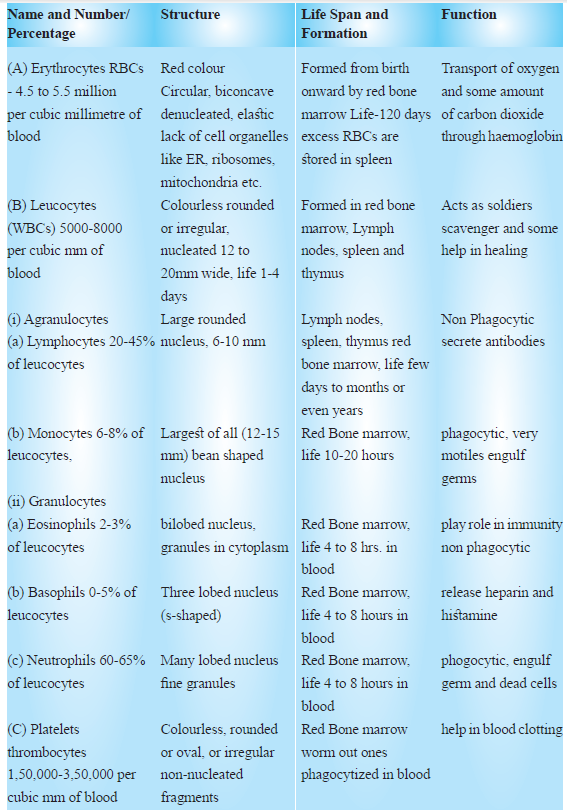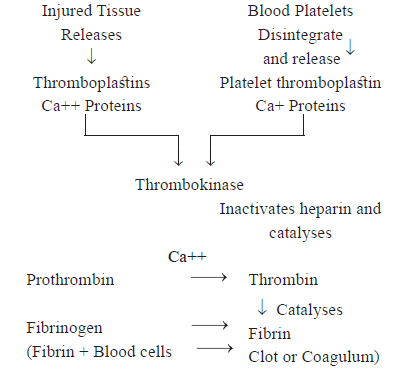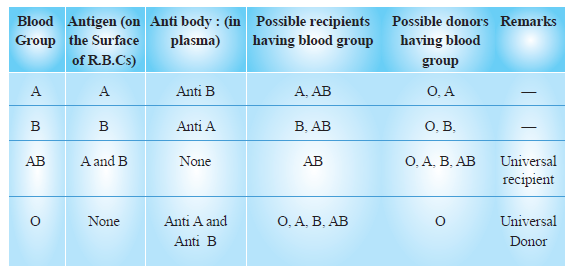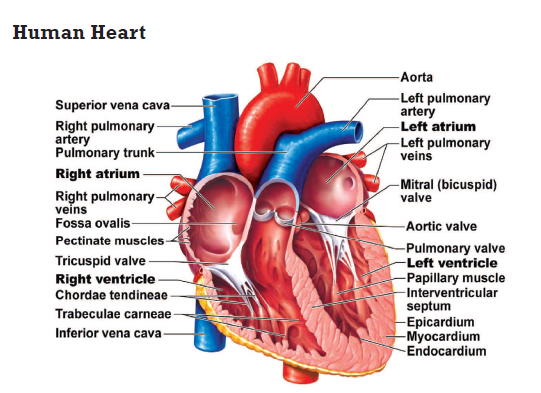Download CBSE Class 11 Biology Body Fluids And Circulation Notes Set B in PDF format. All Revision notes for Class 11 Biology have been designed as per the latest syllabus and updated chapters given in your textbook for Biology in Class 11. Our teachers have designed these concept notes for the benefit of Class 11 students. You should use these chapter wise notes for revision on daily basis. These study notes can also be used for learning each chapter and its important and difficult topics or revision just before your exams to help you get better scores in upcoming examinations, You can also use Printable notes for Class 11 Biology for faster revision of difficult topics and get higher rank. After reading these notes also refer to MCQ questions for Class 11 Biology given on studiestoday
Revision Notes for Class 11 Biology Chapter 15 Body Fluids and Circulation
Class 11 Biology students should refer to the following concepts and notes for Chapter 15 Body Fluids and Circulation in Class 11. These exam notes for Class 11 Biology will be very useful for upcoming class tests and examinations and help you to score good marks
Chapter 15 Body Fluids and Circulation Notes Class 11 Biology
Points To Remember
Blood : A special connective tissue that circulates in principal vascular system of man and other vertebrates consisting of fluid matrix, plasma and formed elements (Blood= Plasma+ All blood cells).
Plasma : (Blood-All blood cells =Plasma) The liquid part of blood which is straw coloured, viscous fluid and contains about 90-92% of water and 6-8% proteins.
Lymph : A clear yellowish, slightly alkaline, coagulable tissue fluid, containing white blood cells (Only lymphocytes), a liquid resembling blood plasma.
Serum : Blood plasma from which fibrinogen and other clotting factors have been removed. (Plasma- (fibrinogen & other clotting factor)= blood serum.
Heart Beat : The rhythmic contraction and relaxation of the heart, which includes one systole (contraction phase) and one diastole (relaxation phase) of the heart. Heart beat count of healthy person is 72 times per minute.
Stroke Volume : The volume of blood pumped out by the heart during a systole. If is approximately 70 ml.
Cardiac output : The amount of blood pumped by heart per minute is called cardiac or heart output. The value of cardiac output of a normal person is about 72 x 70 = 5040 mL or about 5L per minutes.
Cardiac Cycle : The rhythmic contraction and dilation of different parts of heart in one beat.
Systole : Contraction of heart muscles.
Diastole : Relaxation of heart muscle
TYPES OF BLOOD CELLS THEIR NUMBER, STRUCTURE & FUNCTIONS

Blood Pressure-The resistance offered by the lumen of the artery to the flow of Blood.
Hypertension : The condition when blood pressure is higher than normal (120/80 mmHg)
Electrocardiograph :(ECG) the machine used to record electrocardiogram.
Electrocardiogram ECG : The print out of pattern of heart beat taken on a graph paper from Electrocardiograph. (EGC machine)
Lymph
The colourless mobile fluid connective tissue drains into the lymphatic capillaries from the intercellular spaces. It is formed by squeezing of blood through capillaries, within tissues. Its flow is unidirectional i.e., from tissues to heart.
Composition : It is composed of fluid matrix, plasma having only lymphocytes of white blood corpuscles or leucocytes.
Functions : (i) It drains excess of tissue fluid from extra cellular spaces back into the blood.
(ii) It contain lymphocytes and antibodies.
(iii) It transport digested fats.
Blood Clotting : Coagulation of Blood:

Functions of Blood
Transport, of food, respiratory gases (02 and C02), hormones, metabolic intermediates, waste products, supply of raw materials, regulation of water balance, regulation of pH and body temperature, and provides immunity.
Blood Groups : Based on presence of Antigens and Antibodies in blood.

Rh (Rhesus) Group :
Discovered by Landsteiner and Wiener in 1940 the antigen found on the surface ofRBCs. The presence of this antigen is termed as Rh-positive (Rh+) and its absence as (Rh-). It plays a crucial role in childs birth born out of a marriage between Rh- woman and Rh+ man, causing to produce anti Rh antibodies.
→SAN (Sino-artrial node) : A patch of tissues present in the right upper comer of the right atrium, acts are pacemaker due to having a unique property of self exitation.
→AVN (Atrio Ventricular Node) : A mass of tissues seen in the lower left comer of the right atrium close to the atrio-ventricular septum. Fresh wave of contraction generated here, passes over both the ventricles simultaneously along the bundle of his.

Human Heart
- It is the mesodermally derived organ situated in thoracic cavity in between the two lungs. Protected by a double membrane covering called Pericardium.
- Four chambers-two (left and right) atria, and two ventricels (left and right)
- Inner-artrial septum separates the two atria and inter ventricular septum separates the two ventricles, while the atria and ventricles are separated by atrioventricular septum.
- The valves between right atrium and right ventricle is tricuspid while between left atrium and ventricle is bicuspid or mitral value.
- The opening of the right ventricle into the pulmonary artery and the opening of left ventricle in to aorta are guarded by semilunar values.
- The valves allow the flow of blood only in one direction, i.e., from atria to ventricles and from ventricles to pulmonary artery or aorta.
Heart Valves
Tricuspid Valve: The valves formed of three muscular flaps or cups, which guard the opening between the right atrium and the right ventricle.
Bicuspid Valve (Mitral Valve): The valves which guard the opening between the left atrium and the left ventricle, made up of two flaps.
Semilunar Valves : The valves present at the opening of the right and the left ventricles and allow the entry of blood into pulmonary artery and the aorta respectively.
Standat·d ECG & Reading of ECG : ‘P’ Wave represents the electrical excitation (or depolarisation) of the atria and leads to the contraction of both the atria.
Electrocardiogram ECG : The graphic record of the electric current produced by the excitation of the cardiac muscles. It is composed of a ‘P’ wave, ‘QRS’ wave. (complex) and ‘T’ wave (for a standard ECG)

‘QRS’ complex : represents the depolarisation of the ventricles, which initiates the ventricular contraction.
‘T’ Wave : represents the return of the ventricles from excited to normal state (repolarisation). The end ofT-wave marks the end of sytole.
Double circulation :
The passage of same blood twice through heart in order to complete one cycle. i.e. It is completed in following two steps.
(i) Pulmonary Circulation : The blood pumped by the right ventricle (deoxygenated blood) is transported through pulmonary artery to lungs where C02 is exchanged with 02 through diffusion and returns back to the heart through pulmonary vein. It is called pulmonary circulation.
(ii) Systemic Circulation : The oxygenated blood from left ventricle is transported through aorta to different body parts (cells and tissues) where 02 is exchanged with C02 through diffusion and then returned back to the heart through vena-cava. It is called systemic circulation.
Disorders of circulatory System
Hypertension (High blood Pressure) : It results from narrowing of arterial lumen and reduced elasticity of arterial walls in old age. It can cause rupturing of capillaries. It is a silent killer.
Cor·onaryArtery Disease: (CAD) Atherosclerosis. The supply of the blood to heart muscles is affected. It is “caused by deposits of Calcium, fat, cholesterol and fibrous tissues to make the lumen of arteries narrower.
Angina Pectoris : Caused due to arteriosclerosis, when no enough oxygen is reaching the heart muscle due to which the person experiences acute chest pain.
Heart attack : Caused when the heart muscle is suddenly damaged by an inadequate blood supply.
Cardiac arrest : The state in which the heart stops beating.
Arteriosclerosis : The state of hardening of arteries and arterioles due to thickening of the fibrous tissue and consequent loss of elasticity. It causes hypertension.
| CBSE Class 11 Biology The Living World Notes Set A |
| CBSE Class 11 Biology The Living World Notes Set B |
| CBSE Class 11 Biology Plant Kingdom Notes Set A |
| CBSE Class 11 Biology Plant Kingdom Notes Set B |
| CBSE Class 11 Biology Plant Kingdom Notes Set C |
| CBSE Class 11 Biology Animal Kingdom Notes Set A |
| CBSE Class 11 Biology Animal Kingdom Notes Set B |
| CBSE Class 11 Biology Animal Kingdom Notes Set C |
| CBSE Class 11 Biology Morphology Of Flowering Plants Notes Set A |
| CBSE Class 11 Biology Morphology Of Flowering Plants Notes Set B |
| CBSE Class 11 Biology Structural Organisation In Animals Notes Set A |
| CBSE Class 11 Biology Structural Organisation In Animals Notes Set B |
| CBSE Class 11 Biology Cell The Unit Of Life Notes Set A |
| CBSE Class 11 Biology Cell The Unit Of Life Notes Set B |
| CBSE Class 11 Biology Cell The Unit Of Life Notes Set C |
| CBSE Class 11 Biology Biomolecules Notes Set A |
| CBSE Class 11 Biology Biomolecules Notes Set B |
| CBSE Class 11 Biology Respiration In Plants Notes Set A |
| CBSE Class 11 Biology Respiration In Plants Notes Set B |
| CBSE Class 11 Biology Plant Growth And Development Notes Set A |
| CBSE Class 11 Biology Plant Growth And Development Notes Set B |
| CBSE Class 11 Biology Breathing And Exchange Of Gases Notes Set A |
| CBSE Class 11 Biology Breathing And Exchange Of Gases Notes Set B |
| CBSE Class 11 Biology Body Fluids And Circulation Notes Set A |
| CBSE Class 11 Biology Body Fluids And Circulation Notes Set B |
| CBSE Class 11 Biology Neural Control And Coordination Notes Set A |
| CBSE Class 11 Biology Neural Control And Coordination Notes Set B |
| CBSE Class 11 Biology Chemical Coordination and Integration Notes Set A |
| CBSE Class 11 Biology OTBA Guidance Document Set A |
| CBSE Class 11 Biology OTBA Guidance Document Set B |
CBSE Class 11 Biology Chapter 15 Body Fluids and Circulation Notes
We hope you liked the above notes for topic Chapter 15 Body Fluids and Circulation which has been designed as per the latest syllabus for Class 11 Biology released by CBSE. Students of Class 11 should download and practice the above notes for Class 11 Biology regularly. All revision notes have been designed for Biology by referring to the most important topics which the students should learn to get better marks in examinations. Our team of expert teachers have referred to the NCERT book for Class 11 Biology to design the Biology Class 11 notes. After reading the notes which have been developed as per the latest books also refer to the NCERT solutions for Class 11 Biology provided by our teachers. We have also provided a lot of MCQ questions for Class 11 Biology in the notes so that you can learn the concepts and also solve questions relating to the topics. We have also provided a lot of Worksheets for Class 11 Biology which you can use to further make yourself stronger in Biology.
You can download notes for Class 11 Biology Chapter 15 Body Fluids and Circulation for latest academic session from StudiesToday.com
Yes, the notes issued for Class 11 Biology Chapter 15 Body Fluids and Circulation have been made available here for latest CBSE session
There is no charge for the notes for CBSE Class 11 Biology Chapter 15 Body Fluids and Circulation, you can download everything free of charge
www.studiestoday.com is the best website from which you can download latest notes for Chapter 15 Body Fluids and Circulation Biology Class 11
Come to StudiesToday.com to get best quality topic wise notes for Class 11 Biology Chapter 15 Body Fluids and Circulation

